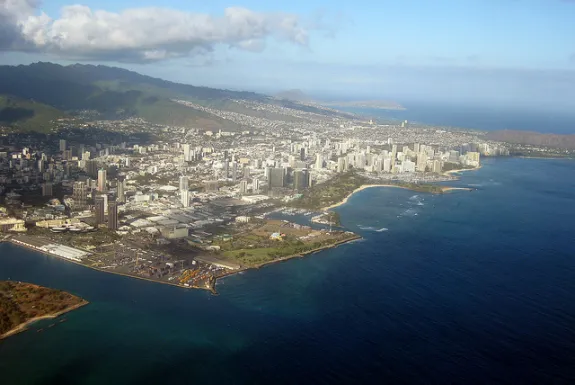Melting Polar Ice Will Spike Sea Levels at the Equator
Expect higher sea levels in the equatorial Pacific and lower ones near the poles by 2100, according to new research
/https://tf-cmsv2-smithsonianmag-media.s3.amazonaws.com/filer/20130221023144Greenland-ice2.jpg)
If you live on the coast, watch out–the shoreline close to home is moving. The planet’s two largest ice sheets, in Antarctica and Greenland, have been melting at an unprecedented pace for the past decade, and ice melt is the biggest contributor to rising sea levels. But not all coasts will draw closer inland. Scientists have determined (PDF) that water levels will rise in some parts of the world and dip in others.
Now, new research published in the journal Geophysical Research Letters and coordinated by the European organization Ice2sea shows in specific detail the effect of ice melt on sea levels by the year 2100.
Looking at Antarctica’s 15 major drainage basins and three glaciers in Greenland, the researchers relied on two ice-loss scenarios–one a mid-range melt and the other a more significant deterioration of glacial ice–and used sophisticated computer modeling to examine where and how severe the alterations in sea level would be. They keyed in on three main factors: Changes in water distribution due to the warming of the oceans; alterations in the Earth’s mass distribution that continue to occur as the crust rebounds after the last ice age, 10,000 years ago; and the fact that as glaciers melt, the Earth’s gravitational pull in the surrounding areas decreases, sending water away from the glaciers and redistributing it to other parts of the world.
What the modeling showed is that water will rush away from some polar regions and toward the equator, making the low-elevation coastal zones of the equatorial Pacific, particularly those with gently dipping shorelines, most vulnerable to rising sea levels. At the same time, water levels in some polar regions will actually drop. The total rise in the worst affected parts of the equatorial oceans could start at two feet and spike to more than three feet. This is in comparison to the six-inch sea-level rise that occurred globally in the 20th century.
In the United States, Hawaii will be hit hard. Both the moderate and more extreme ice-melt scenarios place Honolulu in the crosshairs of rising sea levels. “Honolulu is located in the broad area in the Pacific Ocean where the sea-level fingerprint is expected is expected to attain its largest… amplitude,” the authors wrote. Trouble will be brewing well before 2100, the research shows. In the latter half of the 21st century, sea levels could rise 0.32 inches per year in Hawaii, according to the more severe scenario studied.

Other parts of the U.S. will also be affected, including the Gulf of Mexico and the East Coast, from Miami to New York City. Europe, however, will be relatively unscathed. Its close proximity to the melting ice will slow down sea-level rise. But that’s not entirely good news because it will be at the expense of greater sea-level rise in other parts.
One ramification to these rises is obvious: Coastal flooding. It’s likely that hurricanes, high seasonal waves and tsunamis will send water further inland. Also, new wetlands will be created–which sounds like a theoretical boon, but will alter surface drainage and therefore result in flooding at high tides and during heavy rainfall. In addition, coastal erosion will occur, as will the salinification of coastal groundwater aquifers, creating problems for countries like water-strapped India.
A concern the scientists have is that planners building sea walls and taking other precautionary measures are relying on outdated information. “The most reliable ‘old data’ at our disposal are those saying that sea level HAS BEEN effectively rising, on the average, by 15 to 20 cm during the 20th century,” the study’s lead author, Giorgio Spada of Italy’s University of Urbino, told Surprising Science in an email. “A wall of could be enough… but we have evidence that the sea level rise is accelerating and it is ‘very likely’ that it will rise by more than 20 cm globally during the 21st century.”
Moving forward, the researchers believe that even more detailed modeling is necessary. “We need to get to a higher geographic resolution before we will really be giving planners and policy-makers what they need,” David Vaughan, program coordinator of Ice2Sea told Surprising Science. “There will be some variations in how sea-level rise changes risk between one seaside town and another 100 km down the coast. But we’re not in a position to advise at this level of detail.”
In the meantime, the Intergovernmental Panel on Climate Change (IPCC) is working on its fifth assessment report, a comprehensive analysis of the potential effects of climate change and suggestions for mitigating the risks. Scheduled for publication next year, it will incorporate new research–perhaps even these findings–conducted since the last report, published in 2007.